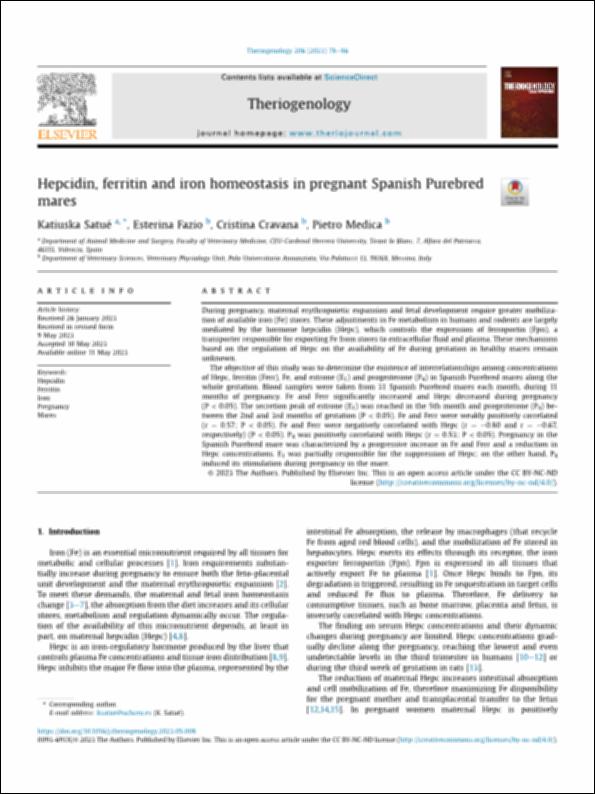Please use this identifier to cite or link to this item:
http://hdl.handle.net/10637/15900Hepcidin, ferritin and iron homeostasis in pregnant Spanish Purebred mares
| Title: | Hepcidin, ferritin and iron homeostasis in pregnant Spanish Purebred mares |
| Authors : | Satué Ambrojo, Katiuska Fazio, Esterina Cravana, Cristina Medica, Pietro |
| Keywords: | Caballos; Horses; Embarazo; Pregnancy; Progesterona; Progesterone; Hierro; Iron; Estrona; Estrone; Homeostasis |
| Publisher: | Elsevier |
| Citation: | Satué, K., Fazio, E., Cravana, C. & Medica, P. (2023). Hepcidin, ferritin and iron homeostasis in pregnant Spanish Purebred mares. Theriogenology, vol. 206 (aug.), pp. 78–86. DOI: https://doi.org/10.1016/j.theriogenology.2023.05.008 |
| Abstract: | During pregnancy, maternal erythropoietic expansion and fetal development require greater mobilization of available iron (Fe) stores. These adjustments in Fe metabolism in humans and rodents are largely mediated by the hormone hepcidin (Hepc), which controls the expression of ferroportin (Fpn), a transporter responsible for exporting Fe from stores to extracellular fluid and plasma. These mechanisms based on the regulation of Hepc on the availability of Fe during gestation in healthy mares remain unknown. The objective of this study was to determine the existence of interrelationships among concentrations of Hepc, ferritin (Ferr), Fe, and estrone (E1) and progesterone (P4) in Spanish Purebred mares along the whole gestation. Blood samples were taken from 31 Spanish Purebred mares each month, during 11 months of pregnancy. Fe and Ferr significantly increased and Hepc decreased during pregnancy (P < 0.05). The secretion peak of estrone (E1) was reached in the 5th month and progesterone (P4) between the 2nd and 3rd months of gestation (P < 0.05). Fe and Ferr were weakly positively correlated (r = 0.57; P < 0.05). Fe and Ferr were negatively correlated with Hepc (r = −0.80 and r = −0.67, respectively) (P < 0.05). P4 was positively correlated with Hepc (r = 0.53; P < 0.05). Pregnancy in the Spanish Purebred mare was characterized by a progressive increase in Fe and Ferr and a reduction in Hepc concentrations. E1 was partially responsible for the suppression of Hepc; on the other hand, P4 induced its stimulation during pregnancy in the mare. |
| URI: | http://hdl.handle.net/10637/15900 |
| Rights : | http://creativecommons.org/licenses/by-nc-nd/4.0/deed.es Open Access |
| ISSN: | 0093-691X 1879-3231 (Electrónico) |
| Supported by: | Acuerdo Transformativo – 2023 |
| Issue Date: | Aug-2023 |
| Center : | Universidad Cardenal Herrera-CEU |
| Appears in Collections: | Dpto. Medicina y Cirugía Animal |
Items in DSpace are protected by copyright, with all rights reserved, unless otherwise indicated.


